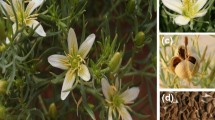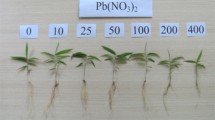Abstract
Baru (Dipteryx alata Vogel) is a native tree plant, widely distributed in Brazil, and has a growth and development in acidic soils like Cerrado, indicating a probable tolerance to adverse soil conditions, such as the high concentration of metals and the acidic pH. Due to the lack of information about the tolerance of this species to metals and the possibility of being used in the recovery of degraded areas and/or in phytoremediation, this work was developed with the objective of evaluating the in vitro germination and growth capacity of baru in medium supplemented with different concentrations of aluminum, iron, and manganese, as well as through chemical analysis, to determine the concentration of metals accumulated in cultivated plants in these conditions. The treatments consisted in different concentrations of metals: aluminum, Al3+ (0, 3.5, 7.0, 10.5, 21.0, or 42.0 mg L−1); iron, Fe3+ (0, 2.5, 4.9, 7.4, 14.7, or 29.4 mg L−1); and manganese, Mn2+ (0, 0.4, 0.8, 1.2, 2.4, or 4.8 mg L−1) added to the medium WPM. The tested values were based on using the lower concentration as the limit value, calculated based on risk to human health in accordance with CONAMA resolution 420/2009 for groundwater. At 60 days of cultivation, the percentage of germination, the average number of leaves, the length of the main root and the aerial part, the fresh and dry mass of the aerial part and the root system and the cations concentration Al3+, Fe3+ and Mn2+ in the plant biomass, were evaluated. The results showed that under the conditions in which the experiment was conducted, germination and in vitro growth of baru were not affected by the presence in high concentrations of any of the evaluated metals, with no differences in the percentage of germination and plant growth, as well as typical toxicity characteristics were not observed, such as changes in root morphology, chlorosis, or tissue oxidation. The absence of toxicity symptoms in baru plants, in the presence of Al3+, Fe3+, and Mn2+, indicate that the species is tolerant to these metals. The accumulation of Al3+ and Fe3+ in the plant biomass at the beginning of growth, simultaneously with the increase in the concentrations of these elements in the culture medium, indicates that this species can be used for phytoremediation, because it is a probable accumulator of these elements throughout its development, given the presence in significant concentrations of these elements also in the seeds.


Similar content being viewed by others
Data Availability
Not applicable
References
Ackova DG (2018) Heavy metals and their general toxicity for plants. Plant Science Today 5(1):14–18. https://doi.org/10.14719/pst.2018.5.1.355
Appenroth KJ (2010) What are “heavy metals” in plant sciences? Acta Physiol Plant 32:615–619. https://doi.org/10.1007/s11738-009-0455-4
Atkins, P., & Jones, L. (1997). Chemistry - molecules, matter and change. (3th ed.). New York: W. H. Freeman & Co (SD) 886
Baldisserotto C, Ferroni L, Anfuso E, Fasulo MP, Pancaldi S (2007) Responses of Trapa natans L. floating laminae to high concentrations of manganese. Protoplasma 231:65–82. https://doi.org/10.1007/s00709-007-0242-2
Bernardino CAR, Mahler CF, Preussler KH, Novo LAB (2016) State of the art of phytoremediation in Brazil - review and perspectives. Water Air Soil Pollut 227:272. https://doi.org/10.1007/s11270-016-2971-3
Bolfe EF, Sano EE, Campos SK (2020) Dinâmica agrícola no cerrado: análises e projeções. Embrapa, Brasília, DF, p 312
Carvalho CS (2020) Dipteryx. In: Flora do Brasil 2020. Jardim Botânico do Rio de Janeiro. http://floradobrasil.jbrj.gov.br/reflora/floradobrasil/FB29628. Accessed 05 February
Čiamporová M (2002) Morphological and structural responses of plant roots to aluminium at organ, tissue, and cellular levels. Biol Plant 45:161–171. https://doi.org/10.1023/A:1015159601881
Conselho Nacional do Meio Ambiente CONAMA (2009) Resolução n° 420 de 28 de dezembro de 2009. http://www2.mma.gov.br/port/conama/res/res09/res42009.pdf. Accessed 05 February
Eckhard G; Horst WJ, Neumann E (2012) Adaptation of plants to adverse chemical soil conditions. In: P., Marschner (Ed.). Marschner’s mineral nutrition of higher plants (409–472). Amsterdam: Academic Press Elsevier
Empresa Brasileira de Pesquisa Agropecuária EMBRAPA (2013) Sistema brasileiro de classificação de solos. (3th ed.). Brasília: EMBRAPA-SPI, Centro Nacional de Pesquisa de Solos 353
Fageria, N. K., & Stone, L. F. (1999). Manejo da acidez dos solos de Cerrado e de várzea do Brasil. Santo Antônio de Goiás: Embrapa Arroz e Feijão, 42p. (Documentos, 92). http://www.infoteca.cnptia.embrapa.br/bitstream/doc/207078/1/doc92.pdf
Fernando DR, Lynch JP (2015) Manganese phytotoxicity: new light on an old problem. Ann Bot 116(3):313–319. https://doi.org/10.1093/aob/mcv111
Ferreira CM, Gabriel GH, Nepomuceno L, Cruz VS, Araújo EG (2018) Caracterização botânica e cadeia produtiva da espécie Dipteryx alata Vogel. Enciclopédia Biosfera 15:201–217. https://doi.org/10.18677/EnciBio_2018B18
Haridasan M (2008) Nutritional adaptations of native plants of the Cerrado biome in acid soils. Braz J Plant Physiol 20(3):183–195. https://doi.org/10.1590/S1677-04202008000300003
Jansen S, Broadley MR, Robbrecht E, Smets E (2002) Aluminum hyperaccumulation in angiosperms: a review of its phylogenetic significance. Bot Rev 68(2):235–269. https://doi.org/10.1663/0006-8101(2002)068[0235:AHIAAR]2.0.CO;2
Jones DL, Ryan PR (2016) Aluminum toxicity. In Encyclopedia of applied plant sciences: plant physiology and development (2th ed 1 211-218). Elsevier. https://doi.org/10.1016/B978-0-12-394807-6.00120-9
Kochian LV (1985) Cellular mechanisms of aluminum toxicity and resistance in plants. Annu Rev Plant Physiol Plant Mol Biol 46:237–260. https://doi.org/10.1146/annurev.pp.46.060195.001321
Kumari KMDV, Narasimham D, Paramesh K, Chandrasekhar T (2016) Impacts of cadmium and manganese on in vitro seed germination and seedling growth of horsegram. Indian Journal of Plant Sciences 5(1):2319–3824 http://www.cibtech.org/J-Plant-Sciences/PUBLICATIONS/2016/12-JPS-012-JOHN-HISTOCHEMICAL.pdf
Lasat MM (2000) Phytoextraction of metals from contaminated soil: a review of plant/soil/metal interaction and assessment of pertinent agronomic issues. Journal of Hazardous Substance Research 2:1–25. https://doi.org/10.4148/1090-7025.1015
Lloyd G, McCown B (1980) Commercially feasible micropropagation of mountain laurel (Kalmia latifolia) by use of shoot-tip culture. Proceedings of the International Plant Propagation Society 30 421- 427
Lorenzi H (2008) Árvores brasileiras: manual de identificação e cultivo de plantas arbóreas do Brasil, 5th edn. Instituto Plantarum, Nova Odessa, p 384
Machado, A. A., Silva, J. G. C., Silveira Junior, P., & Conceição, A. R. (1999). Winstat - Sistema de análise estatística para Windows
Machado JS, Steiner F, Zoz F, Honda GB, Oliveira BLN (2015) Effects of aluminum on seed germination and initial growth of physic nut plants. Revista de Agricultura Neotropical 2(1):24–31. https://doi.org/10.32404/rean.v2i1.248
Malavolta E, Vitti GC, de Oliveira SA (1997) Avaliação do Estado Nutricional das Plantas: princípios e aplicações, 2th edn. Potafos, Piracicaba, p 319
Marschner P, Crowley D, Rengel Z (2011) Rhizosphere interactions between microorganisms and plants govern iron and phosphorus acquisition along the root axis – model and research methods. Soil Biol Biochem 43(5):883–894. https://doi.org/10.1016/j.soilbio.2011.01.005
Nagajyoti PC, Lee KD, Sreekanth TVM (2010) Heavy metals, occurrence and toxicity for plants: a review. Environ Chem Lett 8:199–216. https://doi.org/10.1007/s10311-010-0297-8
Peuke AD, Rennenberg H (2005) Phytoremediation. EMBO Rep 6(6):497–501. https://doi.org/10.1038/sj.embor.7400445
Pollard AJ, Powell KD, Harper FA, Smith JAC (2002) The genetic basis of metal hyperaccumulation in plants. Crit Rev Plant Sci 21:539–566. https://doi.org/10.1080/0735-260291044359
Raij BV, de Andrade JC, Cantarella H, Quaaggio JA (2001) Análise Química para Avaliação da Fertilidade de Solos Tropicais. Instituto Agronômico, Campinas, 285p
Ribeiro JF, Walter BMT (1998) Fitofisionomias do Bioma Cerrado. In: S. M., Sano, S. P., Almeida, (Eds.). Cerrado: ambiente e flora (89-166). Planaltina: EMBRAPA-CPAC
Rout GR, Sahoo S (2015) Role of iron in plant growth and metabolism. Reviews in Agricultural Science 3:1–24. https://doi.org/10.7831/ras.3.1
Santos EF, Santini JMK, Paixâo AP, Furlani Júnior E, Lavres J, Campos M, Reis AR (2017) Physiological highlights of manganese toxicity symptoms in soybean plants: Mn toxicity responses. Plant Physiol Biochem 113:6–19. https://doi.org/10.1016/j.plaphy.2017.01.022
Snowden (nee Cook), R. E. D., & Wheeler, B. D. (1993) Iron toxicity to fen plant species. J Ecol 81(1):35–46. https://doi.org/10.2307/2261222
Sumiahadi A, Acar R (2018) A review of phytoremediation technology: heavy metals uptake by plants. Journal of Earth and Environmental Sciences 142:12–23. https://doi.org/10.1590/S1677-04202005000100005
Verma L, Pandey L (2017) The Effect of iron toxicity on seed germination and early seedling growth of green gram (Vigna radiate L. Wilczek). International Journal of Science and Research 6(8):1427–1430 https://www.ijsr.net/search_index_results_paperid.php?id=ART20176221
Vieira, R. F.; Agostini-Costa, T. da S Silva, DB da Sano SM, & Ferreira FR. (2010) Frutas nativas da região Centro-oeste do Brasil. Brasília: Embrapa Informação Tecnológica 322
Wissemeier AH, Horst WJ (1992) Effect of light intensity on manganese toxicity symptoms and callose formation in cowpea (Vigna unguiculata (L.) Walp.). Plant Soil 143:299–309. https://doi.org/10.1007/BF00007886
Acknowledgements
The authors wish to express their sincere gratitude to the Federal University of Grande Dourados (UFGD), Faculty of Biological and Environmental Sciences (FCBA) and Master’s graduate program in Biodiversity and Environment.
Author information
Authors and Affiliations
Contributions
Conceptualization: Ludmila Osório Castilho Niedack, and Cláudia Roberta Damiani
Data curation: Ludmila Osório Castilho Niedack, Cláudia Roberta Damiani, Lucas Garcia da Silva de Souza, and Laura Eliza de Oliveira Alves
Formal analysis: Cláudia Roberta Damiani
Investigation: Ludmila Osório Castilho Niedack, Lucas Garcia da Silva de Souza, and Laura Eliza de Oliveira Alves
Methodology: Ludmila Osório Castilho Niedack and Cláudia Roberta Damiani
Project administration: Ludmila Osório Castilho Niedack and Cláudia Roberta Damiani
Resources: Cláudia Roberta Damiani
Supervision: Cláudia Roberta Damiani
Validation: Ludmila Osório Castilho Niedack and Cláudia Roberta Damiani
Visualization: Ludmila Osório Castilho Niedack and Cláudia Roberta Damiani
Writing-original draft: Ludmila Osório Castilho Niedack and Cláudia Roberta Damiani
Writing-review and editing: Ludmila Osório Castilho Niedack and Cláudia Roberta Damiani
Corresponding author
Ethics declarations
Ethics approval and consent to participate
Not applicable
Consent for publication
Not applicable
Competing interests
The authors declare no competing interests.
Additional information
Responsible Editor: Elena Maestri
Publisher’s note
Springer Nature remains neutral with regard to jurisdictional claims in published maps and institutional affiliations.
Rights and permissions
About this article
Cite this article
Niedack, L.O.C., da Silva de Souza, L.G., de Oliveira Alves, L.E. et al. Baru (Dipteryx alata Vogel), a woody species characteristic of Cerrado and its phytoremediation potential. Environ Sci Pollut Res 28, 57798–57806 (2021). https://doi.org/10.1007/s11356-021-14708-6
Received:
Accepted:
Published:
Issue Date:
DOI: https://doi.org/10.1007/s11356-021-14708-6




